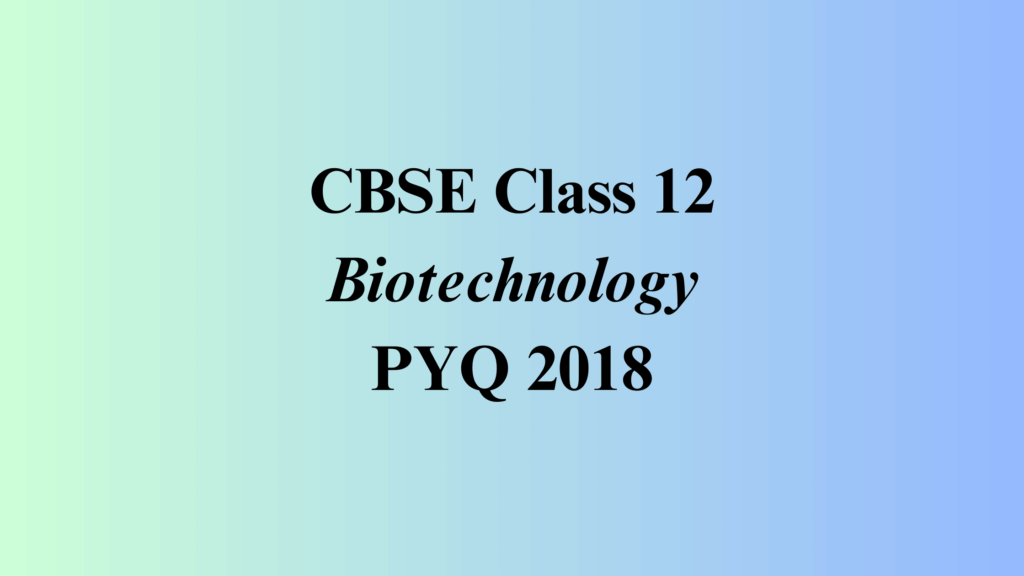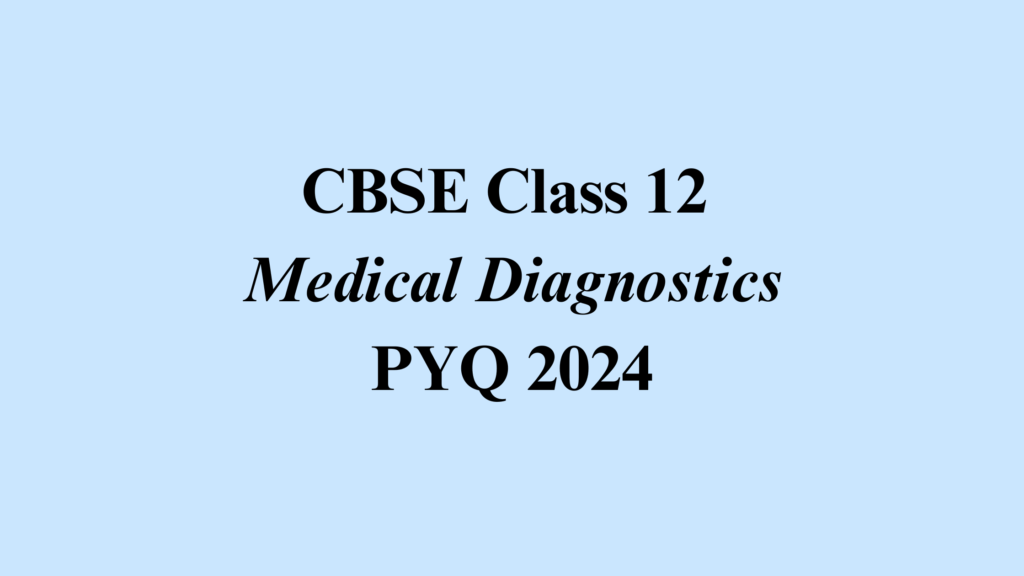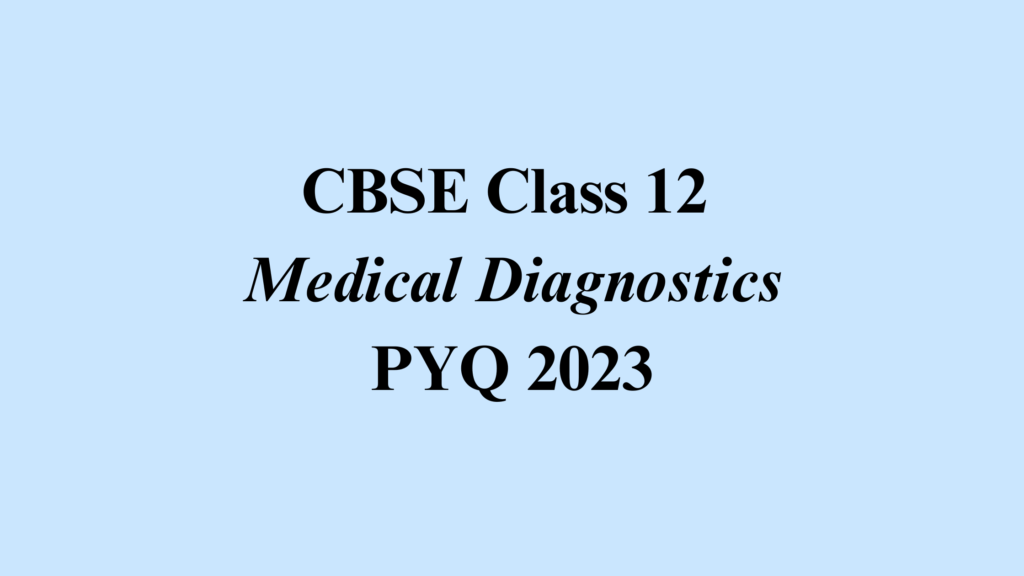Class 12 Biotechnology PYQ 2018 Solved
Time allowed: 3 hours
Maximum Marks: 70
SECTION A
1. Cancer cells lose ‘contact inhibition’, an important feature of normal cells. What is ‘Contact Inhibition’?
Ans. Contact inhibition means that when cells grow and reach the walls of the container (i.e., reach confluency), they stop growing further.
2. Van der Waals forces are weak attractions, but are important in proteins. Why?
Ans. Van der Waals forces are contact forces that increase with the surface area. It is important for proteins because their large surface areas and Van der Waals forces together make the molecule stronger.
3. Write the principle used in measuring bacterial cell growth by spectrophotometer.
Ans. The spectrophotometer principle is based on the fact that small molecules scatter light proportionate to their concentration. When light passes through a suspension of bacteria, there is a reduction in light transmitted as a consequence of scattering.
4. To construct a c-DNA library, reverse transcriptase enzyme is needed. Why?
Ans. Reverse transcriptase is required to isolate mRNA and copy it into the cDNA.
5. For short-term storage of germplasm using explant culture, abscisic acid is added to the medium. What is the purpose of doing so?
Ans. Abscisic acid acts as a growth retardant.
6. Name a technique that can help researchers to observe interactions among thousands of genes simultaneously.
Ans. Microarray using a DNA chip.
SECTION B
7. A biotechnologist wants to develop a variety of rice, which can survive in high salinity. How can he do so?
Ans. By creating transgenic plants by introducing genes that overexpress stress-related osmolytes/osmoprotectants. Examples such as sugars (trehalose), sugar alcohol(mannitol), amino acids (proline), betaines (glycine betaine), etc.
8. Both PCR and M-13 bacteriophage can amplify DNA with respect to the DNA fragment obtained. What is the basic difference between the two?
Ans. PCR produces double-stranded DNA while M-13 produces single-stranded DNA.
9. Differentiate between finite and continuous cell lines.
Any 2 differences:-
| Finite Cell Lines | Continuous Cell Lines |
| (a) Can grow for a longer time/unlimited lifespan | (i) Cells can show the change in ploidy( change in the basic number of chromosomes) |
| (b) Show contact inhibition | (b) Do not show contact inhibition |
| (c) Doubling time is 24 – 96 hours | (c) Doubling time is 12 to 24 hours |
| (d) Show density limitation | (d) Density limitation is reduced or lost. |
| (e) The mode of growth of cells is in monolayer form. | (e) The mode of growth of cells is either monolayer or suspension form |
| (f) Growth rate is slow | (f) Growth rate is rapid |
| (g) Show anchorage dependence | (g) Do not show anchorage dependence |
| (h) Cells are not transformed | (h) Cells are transformed |
| (i) Cells do not show the change in ploidy( change in the basic number of chromosomes) | (i) Cells can show the change in ploidy( change in the basic number ofchromosomes) |
| (j) Any suitable example | (j) Any suitable example |
10. Analysis of m-RNA in a given cell doesn’t provide a direct reflection of its protein content. Give two reasons to support the statement.
Ans.
- mRNA and protein expression levels do not always correlate.
- mRNA could undergo various post-transcriptional modifications, polyadenylation and mRNA editing.
- Translational regulation of mRNA could take place.
11. Downstream processing becomes difficult and costly, if eukaryotic proteins are produced in prokaryotes. Give two reasons.
Ans.
- When a eukaryotic gene (e.g., plant, animal, human) is expressed in a prokaryotic (bacterial) host, there are additional problems to be tackled.
- The non-coding region of a eukaryotic gene must be excised. This requires the use of reverse transcription of mRNA into cDNA.
- Additionally, the recombinant protein may not be secreted into the medium, or its incorrect folding and accumulation intracellularly may generate inclusion bodies. All these problems make downstream processing difficult and costly.
12. How is the blue-white selection method used to screen transformed host cells?
Ans. Insertional inactivation of the Lac Z gene present in the vector. Transformed host cells appear white while the non-transformed host cells appear blue on X-Gal substrate.
13. Differentiate between primary and secondary metabolites in plants.
Ans. Primary metabolites are required for basic metabolic processes, e.g., amino acids, nucleic acids.
Secondary metabolites are additional products that may be required, e.g., in defense mechanisms. E.g.. Antibiotics- Penicillin from Penicillium chrysogenum.
14. Suggest two challenges faced in the area of animal cell culture.
Ans.
- Depending on the tissue they have been isolated from, they can be grown only for a limited generations even in the best nutritive media.
- Shows contact inhibition, when cells grow and reach the walls of the container (i.e., reach confluency) they stop growing further.
SECTION C
15. a. What are Epitopes?
b. Differentiate between monoclonal and polyclonal antibodies.
Ans.
a. The specific sequences of amino acids in the protein that stimulate an immune response are known as epitopes.
b.
| Monoclonal antibodies | Polyclonal antibodies |
| Binds to a specific epitope on an antigen | Binds to multiple epitopes on an antigen |
| It is produced by single clone of B-cells | It is produced by multiple clones of B-cells |
16. What is Molecular Pharming? Give four advantages of producing recombinant proteins in milk.
Ans. The process to create transgenic animals by direct microinjection of DNA into ova or stem cells to produce insulin and other proteins in milk on a commercial scale is called molecular pharming.
Advantages:
- a. High production capacity.
- b. Ease of source material collection
- c. Moderate capital instrument requirements
- d. Low operational cost
- e. Ease of production, including purification and scale-up.
17. Explain how fluorescent DNA probes can be created using ‘Nick Translation’.
Ans. Nick translation (or head translation), developed in 1977 by Rigby and Paul Berg. The DNA polymerase I adds nucleotide residues to the 3-prime hydroxyl terminus that is the result of nicks (breaks) created by the DNase I in the DNA. In the process, the fluorescence-labelled nucleotide in the free nucleotide mixture becomes incorporated into the newly synthesized strands of DNA.
18. What are the main areas of consideration for safety aspects specific to Microbial Culture? (Any three)
Ans. The main areas of consideration for safety aspects specific to biotechnology are:
- Potential of genetically modified organisms (GMOs) or recombinant strains to infect humans, animals, and plants to cause diseases.
- Toxicity and allergy are associated with the use of microbially produced biomolecules, especially the recombinant molecules.
- Other medically relevant implications like increasing the environmental pool of antibiotic-resistant microorganisms or the transfer of antibiotic-resistant genes.
- Problems associated with the disposal of spent microbial biomass.
- Safety aspects associated with contamination, infection or mutation of process strains.
19. Using an example, describe a technique commonly used to compare similar proteins from different sources.
Ans. A popular method called Matrix Assisted Laser Desorption Ionisation (MALDI) is used to volatilize and protonate peptides and proteins. In this procedure,
- The sample is transferred from a condensed phase to a gas phase with the help of a solid matrix.
- Ion formation in MALDI is achieved by directing a pulsed laser beam onto a sample suspended or dissolved in a matrix.
- The matrix absorbs the laser light energy and causes the matrix material to vaporise.
- In the gas phase, the charged molecules are directed by electrostatic lenses from the ionisation source to the mass analyzer.
- Multiply charged ions on analysis show patterns from which the molecular mass can be deduced.
20. In a large scale experiment, it was found that CHO cell lines expressed a protein as 100 mg/500 ml of culture medium. A Biotech company has to produce 1000 gm of this protein. They have two 100 L fermenters each, which can operate only once in a eek. How much time is required to produce the desired amount of protein?
Ans. 106 mg to be produced
100 mg is produced in 0.5
106 mg will be produced in 5000
Hence total volume of culture medium required is 5000
Total capacity of 2 fermentors/week = 2 x 100
Number of weeks = 5000/2 x100
Time required = 25 weeks
21. Depict the technique of Southern Hybridisation with a labelled diagram. Suggest one application of the same.
Ans.
Detection of specific DNA sequences by fluorescence amplification: a color complementation assay. It is based on the simultaneous amplification of two or more DNA segments with fluorescent oligonucleotide primers such that the generation of a color, or combination of colors, can be visualized and used for diagnosis DNA fingerprinting is the process of determining an individual’s DNA characteristics, which are as unique as fingerprints.
22. a. Why do we need different kinds of cloning vectors?
b. What will you observe if you use a YAC vector prepared without Autonomously Replicating Sequence (ARS) as a vector?
c. In order to produce a foreign protein in the host, what is the suitable vector? State one special feature of these type of vectors.
Ans.
- a. DNA fragments are of different sizes, and we need different kinds of cloning vectors to incorporate them into different host cells.
- b. YAC will not replicate
- c. Vectors that are suitable for expressing foreign protein are expression vectors. It has special features such as the incorporation of signals for transcription and translation are incorporated with foreign genes.
23. Name 2 databases commonly used in bioinformatics. What all information do they respectively store? Name any one database retrieval tool and give its application.
Ans. Any two
- EMBL(European Molecular Biology Laboratory)- Nucleotide sequence
- UniProtKB-Annotated protein sequence
- PDB (Protein Database)- Three-dimensional structure of proteins
- Ribosomal RNAdatabase-rRNAsubunit sequences
- PALI database- Phylogenetic analysis and alignment of proteins
Entrez is an integrated database retrieval system. Through this system, one can access literature (in the form of abstracts), sequences, and structures. Entrez is an excellent system for obtaining comprehensive information on a given biological question.
24. Differentiate between ‘Fed-batch culture’ and ‘Continuous culture’.
OR
Why is aeration important for microbial growth? How can proper aeration be achieved in microbial culture grown under lab conditions?
Ans.
| Fed –Batch culture | Continuous culture |
| Subsequently fed with fresh medium | Nutrients are added before it gets exhausted |
| Volume of culture increases | Volume remains constant |
OR
- a. Proper mixing of nutrients and providing O2 for better microbial growth.
- b. Use of Baffle flask and shakers to increase turbulence.
25. Why do cereals and legumes have a limited nutritional quality? Write two genetic engineering approaches that have been used to improve the seed protein quality.
Ans. Due to the deficiency of certain essential amino acids/ vitamins
Two approaches:
- a. Incorporate transgene for amino acids
- b. Endogenous genes are modified to increase essential amino acids.
SECTION D
26. (a) What are stem cells?
(b) Differentiate between pluripotent and multipotent stem cells.
Which of these act as repair system for the body and how?
(c) Give three applications of stem cells in the field of medicine.
- Stem cells are characterized by their ability to renew themselves through mitotic cell division and differentiate into a diverse range of specialized cell types.
- Embryonic cells isolated from the inner cell mass of blastocysts are called pluripotent cells. The adult stem cells found in adult tissues are multipotent cells.
Multipotent cells can act as a repair system for the body by maintaining normal turnover of regenerative organs like blood, skin, etc.
(c) The stem cells are useful in many medical conditions where cells are either dead or injured, or abnormal, such as:
- Leukemia (cancerous blood cells).
- Heart disease, heart attack (cardiac tissue damage).
- Paralysis (spinal cord injury).
- Alzheimer’s, Parkinson’s, Huntington’s (dead brain cells).
- Burns (damaged skin cells).
OR
26. a. What is a ‘‘gene knockout’’ ?
b. Draw a diagram or flow chart to show basic principle of tissue engineering.
c. Enlist two applications of tissue engineering.
OR
a. Plants are cheap chemical factories. Why?
b. How are virus-free plants obtained from virus-infected plants?
c. What can be done to raise
i. hybrids of interspecific cross plants, and
ii. male sterile plants?
Ans.
a. Gene knockout is the process of selectively removing a gene.
b.
c. Tissue engineering potentially offers dramatic improvements in low-cost medical care for hundreds of thousands of patients annually.
Large-scale culturing of human or animal cells-including skin, muscle, cartilage, bone, marrow,
endothelial and stem cells-may provide substitutes to replace damaged components in humans.
OR
a. Plants are amazing and cheap chemical factories that need only water, minerals, sun light and carbon dioxide to produce thousands of sophisticated chemical molecules with different structures.
b. By culturing small meristems (usually less than 1 mm long) collected from virus-infected plants.
c. i. Somatic hybridization
ii. The barnase/barstar system was successfully utilized in producing male sterile/restorer lines in number of crops, particularly mustard for hybrid production.
27. Expand NCBI. Give two advantages for complete sequencing of a genome. What kind of analysis can be made using bioinformatics tools? (Any two)
Ans. NCBI –National Centre for Biotechnology Information.
(Any two) There are several reasons for completely sequencing a genome.
- First, it provides a means for the discovery of all the genes and thus provides an inventory of genes.
- Second, the sequence shows the relationships between genes.
- Third, it provides a set of tools for future experimentation.
- Fourth, sequencing provides an index to draw and organize all genetic information about the organism.
- Fifth, and very important over time, is that the whole genome sequence is an archive for the future, containing all the genetic information required to make the organism.
(Any Two) Many kinds of analysis can be made using various bioinformatics tools. These include:
- Processing raw information: The experimentally determined sequence (raw information) is processed using bioinformatics tools into genes, the proteins encoded, and their function, the regulatory sequences, and inferring phylogenetic relationships.
- Genes: Gene prediction can be done by using computer programs like GeneMark for bacterial genomes and GENSCAN for eukaryotes.
- Proteins: Protein sequences can be inferred from the predicted genes by using simple computer programs.
- Regulatory sequences: Regulatory sequences can also be identified and analysed by using bioinformatics tools.
- Inferring phylogenetic relationships: Information regarding the relationships between organisms can be obtained by aligning multiple sequences, calculating evolutionary distance, and constructing phylogenetic trees.
- Making a Discovery: Using the bioinformatics tools and databases, the functions of unknown genes can be predicted.
28. a. What is the isoelectric point of a protein?
b. Write the principle of 2-D gel electrophoresis.
c. Describe the aqueous two-phase partition process used for purification of proteins.
Ans.
a. The isoelectric point of a protein is the pH at which the net charge on amino acids is zero.
b. Proteins are separated based on isoelectric point in one dimension and based on mass /size in the other dimension.
c. Crude homogenate is added to a biphasic mixture of dextran and PEG. Cellular debris partitions to dextran, and soluble constituents partition to PEG.
Additional Study Materials
- Class 12 Biotechnology Syllabus 2025-26
- Class 12 Biotechnology Question Paper 2024
- Class 12 Biotechnology PYQ 2023 Solved
- Class 12 Biotechnology Question Paper 2022 Solved
- Class 12 Biotechnology Question Paper 2020 Solved
- Class 12 Biotechnology Question Paper 2019 Solved




